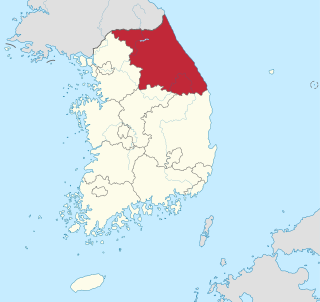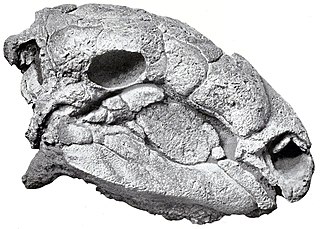
Alberta is a province of Canada. With an estimated population of 4,067,175 as of 2016 census, it is Canada's fourth most populous province and the most populous of Canada's three prairie provinces. Its area is about 660,000 square kilometres (250,000 sq mi). Alberta and its neighbour Saskatchewan were districts of the Northwest Territories until they were established as provinces on September 1, 1905. The premier is Jason Kenney as of April 30, 2019.

Gangwon-do is a province of South Korea, with its capital at Chuncheon. It is bounded on the east part by the East Sea, and borders Gyeonggi Province to its west, and North Gyeongsang Province and North Chungcheong Province to its south. Its northern boundary is the Military Demarcation Line, separating it from North Korea's Kangwŏn Province. Before the division of Korea in 1945 Gangwon and Kangwŏn formed a single province. Pyeongchang County hosted the 2018 Winter Olympics and 2018 Winter Paralympics.

Yanggu County (Yanggu-gun) is a county in Gangwon Province, South Korea.

The Royal Tyrrell Museum is a Canadian tourist attraction and a centre of palaeontological research known for its collection of more than 130,000 fossils.

Dromiceiomimus is a genus of ornithomimid theropod from the Late Cretaceous of Alberta, Canada.

Richardoestesia is a medium-sized genus of theropod dinosaur from the late Cretaceous Period of what is now North America. It currently contains two species, R. gilmorei and R. isosceles.

Philip John Currie is a Canadian palaeontologist and museum curator who helped found the Royal Tyrrell Museum of Palaeontology in Drumheller, Alberta and is now a professor at the University of Alberta in Edmonton. In the 1980s he became the director of the Canada-China Dinosaur Project, the first cooperative palaeontological partnering between China and the West since the Central Asiatic Expeditions in the 1920s, and helped describe some of the first feathered dinosaurs. He is one of the primary editors of the influential Encyclopedia of Dinosaurs, and his areas of expertise include theropods, the origin of birds, and dinosaurian migration patterns and herding behavior. He was one of the models for palaeontologist Alan Grant in the film Jurassic Park.

Chirostenotes is a genus of oviraptorosaurian dinosaur from the late Cretaceous of Alberta, Canada. The type species is Chirostenotes pergracilis.
The Oldman Formation is a stratigraphic unit of Late Cretaceous age that underlies much of southern Alberta, Canada. It consists primarily of sandstones that were deposited in fluvial channel and floodplain environments. It was named for exposures along the Oldman River between its confluence with the St. Mary River and the city of Lethbridge, and it is known primarily for its dinosaur remains and other fossils.

Panoplosaurus is a genus of nodosaurid dinosaur. It was one of the last known nodosaurids, living during the Late Cretaceous in what is now North America; fossils have been located in Alberta, Canada.

Caenagnathidae is a family of bird-like maniraptoran theropod dinosaurs from the Late Cretaceous of North America and Asia. They are a member of the Oviraptorosauria, and close relatives of the Oviraptoridae. Like other oviraptorosaurs, caenagnathids had specialized beaks, long necks, and short tails, and would have been covered in feathers. The relationships of caenagnathids were long a puzzle. The family was originally named by Raymond Martin Sternberg in 1940 as a family of flightless birds. The discovery of skeletons of the related oviraptorids revealed that they were in fact non-avian theropods, and the discovery of more complete caenagnathid remains revealed that Chirostenotes pergracilis, originally named on the basis of a pair of hands, and "Ornithomimus" elegans, named from a foot, were caenagnathids as well.

Albertaceratops was a genus of centrosaurine horned dinosaur from the middle Campanian-age Upper Cretaceous Oldman Formation of Alberta, Canada.
The Dinosaur Trail is a circular tourist route in the province of Alberta, Canada, located in the Canadian badlands paralleling the Red Deer River on both sides, from Drumheller to the Bleriot Ferry. It is divided in two segments, with the South Dinosaur Trail following the south side of the river and uses portions of Highway 575 and Highway 837, while North Dinosaur Trail follows the north side of the river and is the entirety of Highway 838. The north and south segments of Dinosaur Trail are connected by the Highway 9 / Highway 56 concurrency within Drumheller.

Skiff is a hamlet in southern Alberta, Canada within the County of Forty Mile No. 8. It is located on Highway 61, also known as the historic Red Coat Trail, approximately 75 km (47 mi) southeast of Lethbridge.
Boreonykus is an extinct genus of dromaeosaurid dinosaur, that lived during the Late Cretaceous in the area of present Canada.
Albertavenator is a genus of small troodontid theropod dinosaur, known from the early Maastrichtian in the Cretaceous period. It contains a single species, A. curriei, named after paleontologist Phil Currie, based on a partial left frontal found in the Horseshoe Canyon Formation of Alberta during the 1990s. Albertavenator's discovery indicates that small dinosaur diversity may be underestimated at present due to the difficulty in identifying species from fragmentary remains.

The Philip J. Currie Dinosaur Museum is located in Wembley, Alberta. It was named for Canadian paleontologist Phillip J. Currie. The museum opened in September 2015 under the leadership of the founding President & CEO, George Jacob,(https://www.mygrandeprairienow.com/10857/dino-museum-ceo-named-influential-albertan/) winning 9 awards in 9 months. Its location was chosen, in part, due to the proximity of a creek known as the River of Death that has been the source of significant fossil finds. Among the museum's highlights is a skeleton of a Pachyrhinosaurus lakustai dinosaur, considered native to the area.














